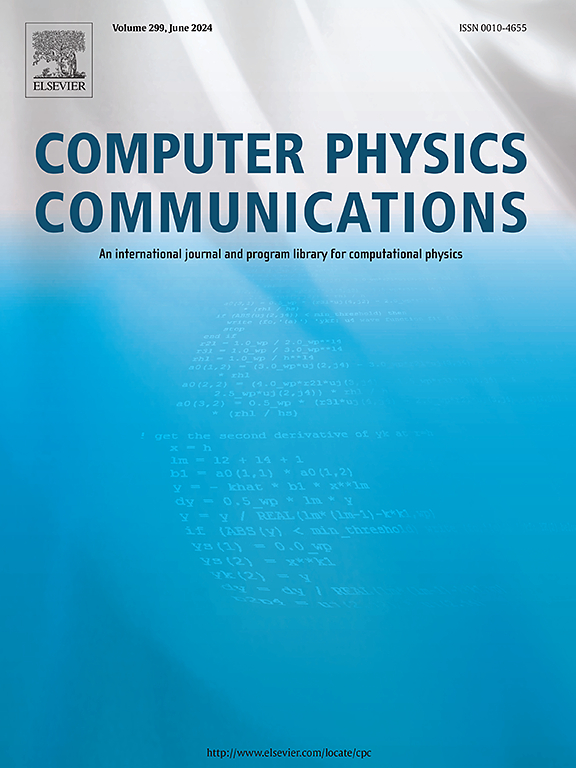The MOOSE fluid properties module
IF 7.2
2区 物理与天体物理
Q1 COMPUTER SCIENCE, INTERDISCIPLINARY APPLICATIONS
引用次数: 0
Abstract
The Fluid Properties module within the Multiphysics Object-Oriented Simulation Environment (MOOSE) is used to compute fluid properties for numerous applications, ranging from nuclear reactor thermal hydraulics to geothermal energy. Those applications drove the development of the module to enable numerous different fluid equations of states, property lookups with primitive and conserved flow variable to cater to pressure and density-driven solvers, and an object-oriented design facilitating expansion and maintenance. Each fluid property is implemented in its own class but inherits capabilities such as automatic differentiation, automated out-of-bounds handling or variable conversion capabilities. This paper presents the module, its design, its user and developer interface, its content in terms of fluids and properties, and several of its applications showing its major role in the MOOSE simulation ecosystem.
Program summary
Program title: MOOSE Fluid Properties module
CPC Library link to program files: https://doi.org/10.17632/cwzhsyp6pd.1
Developer's repository link: https://github.com/idaholab/moose/tree/next/modules/fluid_properties
Licensing provisions: LGPL
Programming language: C++, Python
Nature of problem: The simulation of thermal hydraulics of advanced nuclear reactor systems, such as heat pipe micro-reactors or molten-salt cooled pebble bed reactors, requires a wide variety of discretizations of the fluid flow equations, from 1D thermal hydraulics to computational fluid dynamics at various levels of fidelity, with a wide variety of coolants. Applications are developed within the MOOSE C++ framework by Argonne and Idaho National Laboratories to simulate these reactors for research and design purposes. These applications (Sockeye, SAM, others) rely on MOOSE for the computation of fluid properties. The fluid properties module contains properties for most advanced nuclear reactor coolants, including an interface to the Molten Salt Thermodynamics Database (MSTDB) developed by Oak Ridge National Laboratory. Single phase, two phase, and gas mixtures fluid properties are computed by the module.
Solution method: The fluid properties module includes numerous numerical methods to support the wide range of applications, notably forward automatic differentiation, conversion methods between pressure and density-driven variable sets, spline-based table lookups which are the current state of the art for the fast computation of fluid properties. The integration with MOOSE facilitates uncertainty quantification with regards to the fluid properties and optimization studies with regards to the fluid composition.
MOOSE 流体特性模块
多物理场面向对象仿真环境(MOOSE)中的流体特性模块用于计算从核反应堆热水力学到地热能源等众多应用中的流体特性。这些应用推动了该模块的开发,使其能够实现多种不同的流体状态方程、具有原始和守恒流动变量的属性查询,以满足压力和密度驱动求解器的需要,以及便于扩展和维护的面向对象设计。每个流体属性都在自己的类中实现,但继承了自动微分、自动越界处理或变量转换等功能。本文介绍了该模块及其设计、用户和开发人员界面、流体和属性方面的内容以及几个应用,展示了该模块在 MOOSE 仿真生态系统中的重要作用:MOOSE 流体属性模块CPC 库与程序文件的链接:https://doi.org/10.17632/cwzhsyp6pd.1Developer's repository 链接:https://github.com/idaholab/moose/tree/next/modules/fluid_propertiesLicensing provisions:LGPL 编程语言:C++、Python问题性质:先进核反应堆系统(如热管微堆或熔盐冷却鹅卵石床反应堆)的热水力学模拟需要对流体流动方程进行多种离散化处理,从一维热水力学到不同保真度的计算流体动力学,并使用多种冷却剂。阿贡国家实验室和爱达荷国家实验室在 MOOSE C++ 框架内开发了一些应用程序,用于模拟这些反应堆,以达到研究和设计目的。这些应用程序(Sockeye、SAM 等)依靠 MOOSE 计算流体特性。流体特性模块包含大多数先进核反应堆冷却剂的特性,包括与橡树岭国家实验室开发的熔盐热力学数据库 (MSTDB) 的接口。单相、两相和气体混合物的流体特性由模块求解法计算:流体性质模块包括多种数值方法,以支持广泛的应用,特别是正向自动微分、压力和密度驱动变量集之间的转换方法、基于样条线的表格查找,这些都是当前快速计算流体性质的最先进方法。与 MOOSE 的集成有助于流体特性的不确定性量化和流体成分的优化研究。
本文章由计算机程序翻译,如有差异,请以英文原文为准。
求助全文
约1分钟内获得全文
求助全文
来源期刊

Computer Physics Communications
物理-计算机:跨学科应用
CiteScore
12.10
自引率
3.20%
发文量
287
审稿时长
5.3 months
期刊介绍:
The focus of CPC is on contemporary computational methods and techniques and their implementation, the effectiveness of which will normally be evidenced by the author(s) within the context of a substantive problem in physics. Within this setting CPC publishes two types of paper.
Computer Programs in Physics (CPiP)
These papers describe significant computer programs to be archived in the CPC Program Library which is held in the Mendeley Data repository. The submitted software must be covered by an approved open source licence. Papers and associated computer programs that address a problem of contemporary interest in physics that cannot be solved by current software are particularly encouraged.
Computational Physics Papers (CP)
These are research papers in, but are not limited to, the following themes across computational physics and related disciplines.
mathematical and numerical methods and algorithms;
computational models including those associated with the design, control and analysis of experiments; and
algebraic computation.
Each will normally include software implementation and performance details. The software implementation should, ideally, be available via GitHub, Zenodo or an institutional repository.In addition, research papers on the impact of advanced computer architecture and special purpose computers on computing in the physical sciences and software topics related to, and of importance in, the physical sciences may be considered.
 求助内容:
求助内容: 应助结果提醒方式:
应助结果提醒方式:


